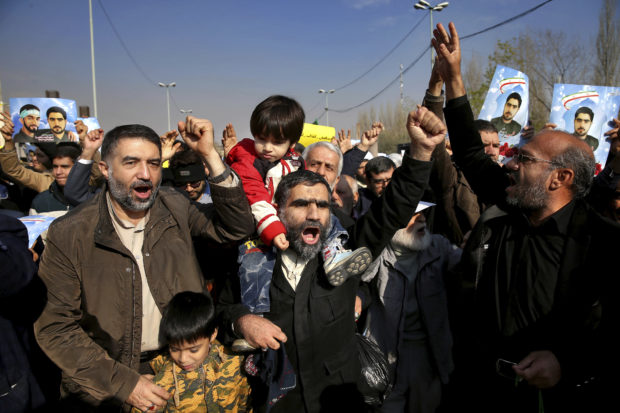Hard-line cleric says social media fed Iran protests, unrest

Iranian worshippers chant slogans during a rally against anti-government protestors after the Friday prayer ceremony in Tehran, Iran, Jan. 5, 2018. A hard-line Iranian cleric has called on Iran to create its own indigenous social media apps, blaming them for the unrest that followed days of protest in the Islamic Republic over its economy. (AP Photo/Ebrahim Noroozi)
DUBAI, United Arab Emirates — A hard-line cleric leading Friday prayers in Iran’s capital called on the Islamic Republic to build its own social media, blaming popular international messaging apps for the unrest that accompanied days of protests over the country’s flagging economy.
The demonstrations began on Dec. 28 and quickly spread across the country, prompting the government to suspend access to the messaging app Telegram, which was being used to publicize the protests, and briefly block the Instagram photo-sharing site. Twitter and Facebook were already banned.
With travel restricted across Iran, a nation of 80 million people roughly two-and-a-half times the size of Texas, online videos and images posted by activists have provided some of the only glimpses into the demonstrations, the largest in nearly a decade, which have mainly been held in the provinces.
Such images only provide a limited view of events on the ground, and can be easily manipulated. All of Iran’s radio and television stations are state-run.
“Cyberspace was kindling the fire of the battle,” Ayatollah Ahmad Khatami told thousands of worshippers gathered in Tehran. “When cyberspace was closed down, the sedition was stopped. The nation does not support a social network that has its key in the hands of the United States.”
Article continues after this advertisementAmid the unrest and anti-government rallies that began last week, Iran has also seen three days of pro-government demonstrations, with crowds in the tens of thousands. A similar rally followed Friday prayers in Tehran.
Article continues after this advertisementOn Thursday, Interior Minister Abdolreza Rahmani Fazli said about 42,000 people at most took part in the week of anti-government protests, saying they went on as long as they did because of the “leniency, restrain, tolerance and interaction” of the government. He did not elaborate.
Fazli’s comments marked the first government estimate of participation in the protests and appeared timed so authorities could contrast it against the mass crowds brought together for the pro-government demonstrations.
The government’s move to block Telegram may have seriously curtailed protesters’ ability to organize. The app boasts an estimated 48 million users in Iran, more than half the population.
“Communication blackouts constitute a serious violation of fundamental rights,” a group of United Nations human rights experts warned in a statement Friday.
The White House has acknowledged looking at ways to help Iranian protesters access social media, but hasn’t made any decisions on how to do so. President Donald Trump has repeatedly tweeted praise for the protesters, infuriating Iranian officials.
Iran briefly blocked Instagram before restoring access. Iran also has restored access to WeChat, a Chinese messaging app.
Videos of protests seen by The Associated Press purported to show demonstrators in Tehran on Thursday night, some chanting: “Death to Khamenei!” referring to Iran’s supreme leader, Ayatollah Ali Khamenei. On Friday, however, streets were calm ahead of the pro-government demonstrations.
At a soccer match Friday in Tabriz, a city in Iran’s East Azerbaijan province some 525 kilometers (330 miles) northwest of Tehran, fans chanted: “People of Azerbaijan won’t accept humiliation!”
Foreign activists said protests were held in other cities as well, but the AP could not independently verify that. Iranian state media carried no such report.
At an emergency meeting of the U.N. Security Council called by the United States on Friday, U.S. Ambassador Nikki Haley portrayed the protests as a human rights issue that could spill over into an international problem.
“The world should applaud their courage” and amplify their message, Haley said. “The Iranian regime is now on notice: The world will be watching what you do.”
But Russia and Iran complained that the U.S. was dragging the U.N.’s most powerful body into what they called a domestic matter.
“The United States is abusing the platform of the Security Council,” said Russian Ambassador Vassily Nebenzia, whose country has close ties to Iran. “Let Iran deal with its own problems.”
At least 21 people have been killed in the unrest surrounding the protests, which began last week over rising food prices and soaring unemployment before spreading to cities across nearly all of Iran’s provinces. Authorities say the protests are waning.
Iran on Thursday directly blamed a CIA official for the protests. The Trump administration has denied having any hand in the protests, and the CIA declined to comment.
Khatami repeated those accusations during his sermon, saying Israel and Saudi Arabia backed the American efforts that used Iranian exile groups, like the Mujahedeen-e-Khalq.
State television reported on Friday that Iranian security forces arrested three suspected MEK members in the city of Boroujerd, some 300 kilometers (185 miles) southwest of Tehran. It said the team was involved in “many sabotage activities” in recent days, without elaborating.
Shahin Gobadi, an MEK spokesman based in Paris, said he knew nothing about the arrests, adding: “The MEK has never resorted to sabotage.”
The Sunni extremists of the Islamic State group meanwhile declared their support for the anti-government protests in Shiite-ruled Iran, describing them as a “revolution against the regime.” IS claimed responsibility for a rare attack in Tehran in June that killed 17 people at Iran’s parliament and the mausoleum of Ayatollah Ruhollah Khomeini, the leader of the 1979 Islamic Revolution.
Khatami called for internet apps to have their servers in Iran and the Iranian government to oversee their operations. He also said those who burn Iran’s flag should face the death penalty. Many in Iran only learned of the flag burning at protests through online videos.